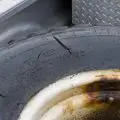Hey! This site is reader-supported and we earn commissions if you purchase products from retailers after clicking on a link from our site.
During my travels in various RVs throughout our country over the last few decades, I have come to understand the need to properly level your rig. When I first started camping in a late 1960s Shasta camper that I bought for $250 in 1983, leveling your camper wasn’t that important. To be honest with you, over the years I’ve never been too particular about leveling my rigs, but with todays technology it’s almost a must to properly level your RV.
For example, my first camper was exceedingly small and offered little amenities compared with what is available in todays marketplace. One such amenity would be a refrigerator using electric shore power, or propane to cool your food. However, these types of refrigerators won’t operate correctly if your RV is not properly leveled. Slide-outs that are extended when your RV isn’t level can cause undo stress on your RV, the slide-out and the motors for your slide-out. Also, an unlevel rig can cause window and door frames to torque out of shape and further damage those components too.
If you’re like me, and don’t have the luxury of a factory installed automated leveling system on your RV, then this guide to leveling your RV should give you a good idea of its importance as well as some of the modern tools available for today’s full and part-time RVers when leveling their rigs.
What is automated leveling?
Larger RVs such as many 5th wheels and class A motorhomes can be ordered with automated levelers. These typically rely upon hydraulic cylinders that retract into the storage areas of rig when not in use. When deployed, they drop down at the push of a button and level your rig.
However, a major drawback to these automated hydraulic cylinders is that when not used properly, they can cause a tremendous amount of damage to your campsite whether you’re boondocking or staying at a paid accommodation such as private or public campgrounds. As many of you folks that regularly follow my articles know, I have spent a lot of my time working and traveling at the same time. During these times, I’ve worked frequently as a campground host and too often I have had to repair a campsite where the owners of a big RV deployed their automated hydraulic jacks and damaged the site because they failed to distribute the weight of their rig properly. In other words, whether you have a large RV or a smaller rig, you should always have some pieces of wood or concrete blocks to spread out the weight distribution of your RV where it come in contact with your campsite. To do otherwise would be irresponsible as a conscientious RVer and a disappointment to those that must repair the holes your jacks left when you pulled anchor and left.
Are there alternatives if you don’t have an automated leveling system?
Yes, one alternative is to use a power jack. This tool can be easily bolted to the tongue of your trailer and when wired into your trailers electrical system it will save you a lot of time when leveling your camper.
- EASY INSTALLATION — Complete with all necessary hardware and pins, installation for the Power...
- TIME-SAVING — Say goodbye to cranking your manual jack. With the push of a button, you can raise...
- INTEGRATED LIGHTING — Four integrated LED lights illuminate the ball and coupler, so you can...
Last update on 2024-04-22 / Affiliate links / Images from Amazon Product Advertising API
This jack is rated for up to 3,500 lbs. so it will work nicely for small and most medium sized trailers. Another good feature of this 30-amp jack is that it’s equipped with four LED lights that shine down at its base and the coupling unit, so it works well if you need to set up camp at night.
You can also install electric stabilizer jacks where needed on your camper and in some cases a motorhome. However, you should keep in mind that these are stabilizer jacks and they should not be used to level your RV.
- POWERFULLY DESIGNED — No more cranking. With the PSX1, campers can stop wasting time and energy...
- RUGGED VERSATILITY — We designed our stabilization system to automatically adjust to uneven,...
- DURABLE CONSTRUCTION — Built with heavy gauge steel, embossed legs and a powder-coat finish —...
Last update on 2024-04-22 / Affiliate links / Images from Amazon Product Advertising API
Unlike factory installed automated levelers that extend to varied lengths due to how level the terrain below them is, stabilizer jacks extend equally on both sides so it’s likely you’ll need to place leveling blocks under them to completely stabilize your rig.
What are leveling blocks?
Leveling blocks can come in various forms. Personally, I keep a varied supply of leveling blocks in my RV and they range from wooden to the more highly engineered plastic models such as these from Camco®. Much like the children’s toy made by Lego®, these leveling blocks are interchangeable and work well when constructed using their lockable design. They work well in different locations and they come in exceedingly handy when setting up camp in mountainous regions such as Wyoming, Colorado, Montana, Idaho and Utah where it’s more likely you’ll have uneven sites in campgrounds or when boondocking.
- CUSTOMIZABLE RV LEVELING SYSTEM: These interlocking RV wheel blocks offer a reliable way to achieve...
- COMPATIBILITY: Camco’s leveling blocks work with single wheels, double wheels, hydraulic jacks,...
- SIZE & CONSTRUCTION: These durable resin blocks each measure 8 ½″ x 8 ½″ x 1 ½″. (10)...
Last update on 2024-04-22 / Affiliate links / Images from Amazon Product Advertising API
Be sure to check out our recommendations for the best RV leveling blocks too.
One of my favorite leveling tools is this model shown below. When deployed under a wheel, it can raise your RV from a half of an inch up to four and a half inches. You can either back up on the leveler or you can pull forward onto them, and once you have leveled your rig to your satisfaction, you can easily slip the wheel chock part of the leveler under the other part and this will prevent the trailer from rolling off the leveler.
- 🛻[MUST HAVE FOR CAMPERS OR FIFTH WHEEL]: Works great on trailers up to 30,000 lbs and with tires...
- 🛻[EASY TO USE]: Just drive on, decide how high you want it and place the chocks! You'll be ready...
- 🛻[FAST & PRECISE LEVELING]: Avoid the hassle of setting up your camper with travel trailer...
Last update on 2024-04-22 / Affiliate links / Images from Amazon Product Advertising API
This design works perfectly for single axle leveling; however, it has an issue if you’re trying to utilize it with two or more axles. The problem is due to the length of the leveler and the distance between your axle’s tires. Basically, the leveler is too long to work as it was designed to, when placed in between two or more trailer tires. In fact, the manufacturer suggests that if you have this issue, you should use a hacksaw or a jigsaw to trim the excess plastic off the leveler you intend to use between the axles.
While I do recommend this leveler because of its ease of use, weight, storability, and its affordability, I do find it odd that the manufacturer would suggest that you damage their product to make it work for your circumstances. Since these components appear to be manufactured using high strength plastic injection molding methods, why doesn’t the manufacturer design a smaller mold that addresses this issue specifically?
Can I make my own levelers?
Absolutely! I love a good DIY task and in a future project, I’ll share some of my ideas about designing and building your own levelers from wood and why they’re likely to work better for you over time.
Final thoughts
Leveling your RV is essential when traveling full-time, part-time, staying at a campground and even boondocking. Frankly, properly leveling your RV is in the best interest of maintaining the integrity of your rig, its value and the terrain you’ve set your anchor upon.
With that said, always remember to equalize the weight distribution between your jack’s landing skids and the ground. Spread the weight out and minimize any damage to our earth.
As always, my friends, thanks for reading, thanks for your kind comments, and thanks for your thoughts. Rock on my friends. I hope to see you on the road someday.









